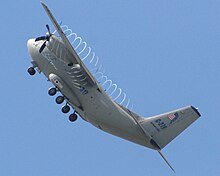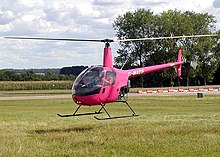


In fluid dynamics, disk loading or disc loading is the average pressure change across an actuator disk, such as an airscrew. Airscrews with a relatively low disk loading are typically called rotors, including helicopter main rotors and tail rotors; propellers typically have a higher disk loading.[1] The V-22 Osprey tiltrotor aircraft has a high disk loading relative to a helicopter in the hover mode, but a relatively low disk loading in fixed-wing mode compared to a turboprop aircraft.[2]
- ^ Stepniewski, W. Z.; Keys, C. N. (1984). Rotary-Wing Aerodynamics. New York: Dover Publications. p. 3. ISBN 0-486-64647-5. OCLC 565962623.
It is interesting to note that there has always been a strong intuitive association of rotary-wing aircraft with low disc loading which is reflected in the commonly accepted name of rotor given to their lifting airscrews.
- ^ Wang, James M.; Jones, Christopher T.; Nixon, Mark W. (1999-05-27). A Variable Diameter Short Haul Civil Tiltrotor. 55th Annual Forum of the American Helicopter Society. Montreal, Quebec, Canada. CiteSeerX 10.1.1.45.612.
The variable diameter tiltrotor (VDTR) is a Sikorsky concept aimed at improving tiltrotor hover and cruise performance currently limited by disk loading that is much higher in hover than conventional helicopter, and much lower in cruise than turbo-prop systems.